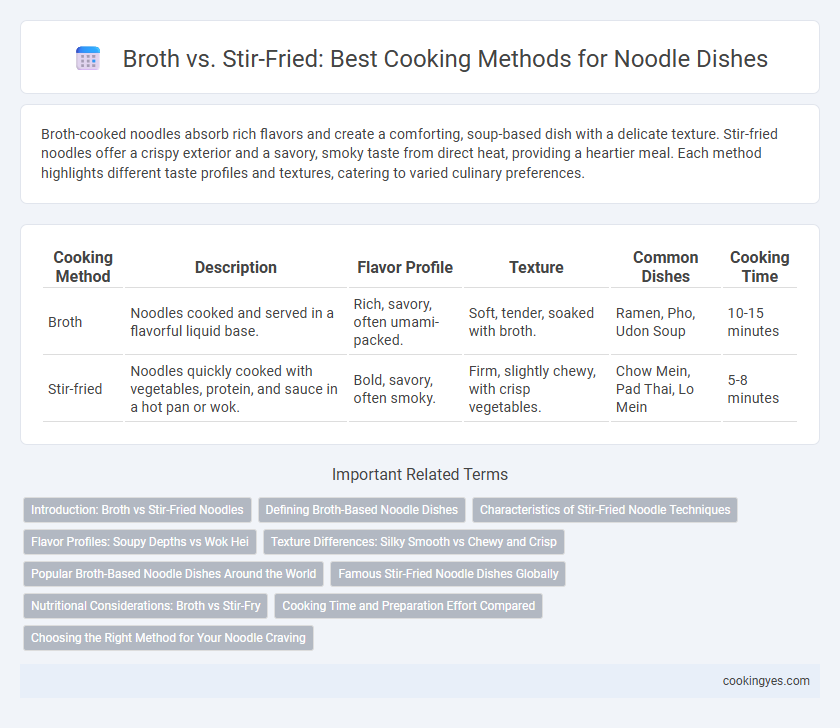Broth-cooked noodles absorb rich flavors and create a comforting, soup-based dish with a delicate texture. Stir-fried noodles offer a crispy exterior and a savory, smoky taste from direct heat, providing a heartier meal. Each method highlights different taste profiles and textures, catering to varied culinary preferences.
Table of Comparison
| Cooking Method | Description | Flavor Profile | Texture | Common Dishes | Cooking Time |
|---|---|---|---|---|---|
| Broth | Noodles cooked and served in a flavorful liquid base. | Rich, savory, often umami-packed. | Soft, tender, soaked with broth. | Ramen, Pho, Udon Soup | 10-15 minutes |
| Stir-fried | Noodles quickly cooked with vegetables, protein, and sauce in a hot pan or wok. | Bold, savory, often smoky. | Firm, slightly chewy, with crisp vegetables. | Chow Mein, Pad Thai, Lo Mein | 5-8 minutes |
Introduction: Broth vs Stir-Fried Noodles
Broth noodles, such as ramen and pho, are cooked by immersing them in rich, flavorful liquids that enhance texture and absorb savory aromas. Stir-fried noodles, like pad thai and chow mein, combine high-heat cooking with diverse vegetables, proteins, and sauces to create a caramelized, slightly crispy dish. Each method highlights unique culinary traditions, influencing the noodle's taste, mouthfeel, and overall dining experience.
Defining Broth-Based Noodle Dishes
Broth-based noodle dishes consist of noodles served in a flavorful, often simmered liquid made from bones, meat, vegetables, and aromatic spices that infuse depth and richness into the dish. These dishes highlight the balance between the umami-rich broth and the texture of the noodles, creating a comforting and nourishing meal. Popular examples include ramen, pho, and laksa, where the broth acts as the main flavor carrier, distinguishing them from stir-fried preparations.
Characteristics of Stir-Fried Noodle Techniques
Stir-fried noodle techniques involve cooking noodles quickly over high heat with a small amount of oil, preserving a firm texture and enhancing natural flavors through caramelization. This method allows for even coating of sauces and ingredients, creating a rich, savory profile with a slight smoky aroma known as "wok hei." Stir-fried noodles typically exhibit a glossy appearance and a balanced blend of textures from tender vegetables and protein mixed with the slightly crispy, chewy noodles.
Flavor Profiles: Soupy Depths vs Wok Hei
Broth-based noodles offer rich, savory depth with slow-cooked stock that infuses each strand with umami and complex aromas. Stir-fried noodles showcase wok hei, imparting a smoky char and a crisp texture through high-heat searing and quick tossing. The contrast between soupy depth and wok hei defines distinct flavor profiles that highlight traditional noodle cooking techniques.
Texture Differences: Silky Smooth vs Chewy and Crisp
Broth-cooked noodles absorb liquid, resulting in a silky smooth texture that complements the warmth and flavor of the soup. Stir-fried noodles feature a slightly crispy exterior and chewy bite from high-heat cooking, offering contrasting textures in each mouthful. The choice between broth and stir-fried methods significantly alters noodle texture, enhancing either softness or a satisfying al dente chew.
Popular Broth-Based Noodle Dishes Around the World
Broth-based noodle dishes like Japanese ramen, Vietnamese pho, and Chinese beef noodle soup showcase rich, flavorful soups that infuse noodles with aromatic spices and slow-cooked ingredients, enhancing taste and texture. These dishes often feature clear or creamy broths made from meats, bones, and herbs, providing a comforting and nourishing meal. The steaming broth not only softens the noodles perfectly but also serves as a vital component that harmonizes with toppings such as sliced meats, vegetables, and fresh herbs.
Famous Stir-Fried Noodle Dishes Globally
Stir-fried noodles are celebrated worldwide for their rich, savory flavors and diverse ingredient combinations, with iconic dishes like Pad Thai from Thailand, Chow Mein from China, and Yakisoba from Japan showcasing unique regional spices and cooking techniques. These dishes typically involve high-heat cooking that enhances noodle texture and caramelizes sauce ingredients, creating a complex taste profile. Unlike broth-based noodles, stir-fried versions emphasize bold seasoning and ingredients such as soy sauce, garlic, and various vegetables, making them a popular choice in global street food and restaurant menus.
Nutritional Considerations: Broth vs Stir-Fry
Broth-based noodles generally offer lower calorie content and higher hydration levels due to their liquid nature, making them a suitable option for those seeking lighter meals with enhanced nutrient absorption from simmered ingredients like bones, vegetables, and spices. Stir-fried noodles, while often higher in calories and fats from added oils and sauces, provide greater protein and vitamin retention, especially when packed with a variety of fresh vegetables and lean meats, supporting muscle maintenance and antioxidant intake. Choosing between broth and stir-fried noodles depends on dietary goals, with broth focusing on hydration and ease of digestion, and stir-fry emphasizing nutrient density and satiety.
Cooking Time and Preparation Effort Compared
Broth-based noodle dishes generally require longer cooking times due to the need for simmering flavorful stock, which enhances depth and complexity. Stir-fried noodles have shorter preparation and cooking times, as ingredients are quickly sauteed over high heat, making this method more efficient and suitable for fast meals. The choice between broth and stir-fried noodles depends on balancing desired flavor intensity and available cooking time.
Choosing the Right Method for Your Noodle Craving
Broth-based noodle dishes offer a comforting, flavorful experience with rich, savory liquids that infuse the noodles, ideal for a warming meal. Stir-fried noodles provide a quick, textured option with crispy vegetables and a bold, caramelized sauce, perfect for a satisfying and flavorful bite. Selecting the right method depends on whether you crave a hearty soup or a savory, wok-tossed delight.
Broth vs Stir-fried for noodle cooking method Infographic

 cookingyes.com
cookingyes.com